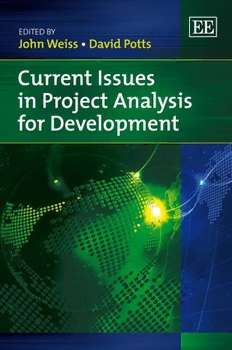Table Of ContentCurrent Issues in
Project Analysis for
Development
Edited by
John Weiss
Professor of Development Economics and Associate Dean,
Research, University of Bradford, UK
David Potts
Senior Lecturer, Bradford Centre for International
Development, University of Bradford, UK
Edward Elgar
Cheltenham, UK • Northampton, MA, USA
MM22991177 -- WWEEIISSSS 99778811884488444455335522 PPRRIINNTT..iinndddd iiiiii 2211//0066//22001122 1144::0077
MM22991177 -- WWEEIISSSS 99778811884488444455335522 PPRRIINNTT..iinndddd vviiiiii 2211//0066//22001122 1144::0077
© John Weiss and David Potts 2012
All rights reserved. No part of this publication may be reproduced, stored in a
retrieval system or transmitted in any form or by any means, electronic,
mechanical or photocopying, recording, or otherwise without the prior
permission of the publisher.
Published by
Edward Elgar Publishing Limited
The Lypiatts
15 Lansdown Road
Cheltenham
Glos GL50 2JA
UK
Edward Elgar Publishing, Inc.
William Pratt House
9 Dewey Court
Northampton
Massachusetts 01060
USA
A catalogue record for this book
is available from the British Library
Library of Congress Control Number: 2012935268
ISBN 978 1 84844 535 2 (cased)
Typeset by Servis Filmsetting Ltd, Stockport, Cheshire
Printed and bound by MPG Books Group, UK
2
0
MM22991177 -- WWEEIISSSS 99778811884488444455335522 PPRRIINNTT..iinndddd iivv 2211//0066//22001122 1144::0077
MM22991177 -- WWEEIISSSS 99778811884488444455335522 PPRRIINNTT..iinndddd vviiiiii 2211//0066//22001122 1144::0077
Contents
List of contributors vii
1 Editors’ introduction 1
David Potts and John Weiss
2 Estimating a shadow exchange rate 30
Elio Londero
3 Shadow wage rates in a changing world 59
David Potts
4 Semi- input–output methods of shadow price estimation:
are they still useful? 74
David Potts
5 Projects and the MDGs: estimating poverty impact 100
Manabu Fujimura
6 Projects and risk 123
John Weiss and Keith Ward
7 Discounting: does it ensure intergenerational equity? 136
Erhun Kula
8 Environmental valuation 161
P.B. Anand
9 Assessing the benefi ts of new or improved roads 189
Chris Nash
10 Project appraisal in health: cost eff ectiveness approaches 200
John Weiss
11 Measuring benefi ts from education 215
David Potts
12 Cost–benefi t analysis traditions: the approach of EU regional
policy 228
Massimo Florio and Silvia Vignetti
v
MM22991177 -- WWEEIISSSS 99778811884488444455335522 PPRRIINNTT..iinndddd vv 2211//0066//22001122 1144::0077
vi Contents
Bibliography 249
Index 279
MM22991177 -- WWEEIISSSS 99778811884488444455335522 PPRRIINNTT..iinndddd vvii 2211//0066//22001122 1144::0077
Contributors
P.B. Anand is Reader in Environmental Economics and Head of Division,
Bradford Centre for International Development, University of Bradford,
UK
Massimo Florio is Professor of Public Economics, Department of
Economics, Business and Statistics at the University of Milan, Italy
Manabu Fujimura is Professor of Economics at Aoyama Gakuin
University, Tokyo, Japan
Erhun Kula is Professor of Economics, Bahçeşehir University, Istanbul,
Turkey
Elio Londero is a Consulting Economist and retired staff member of the
Inter- American Development Bank
Chris Nash is Research Professor, Institute for Transport Studies,
University of Leeds, UK
David Potts is Senior Lecturer, Bradford Centre for International
Development, University of Bradford, UK
Silvia Vignetti is Director of the Evaluation Unit, Centre for Industrial
Studies, Milan, Italy
Keith Ward is an economic consultant
John Weiss is Professor of Development Economics and Associate Dean,
Research, School of Social and International Studies, University of
Bradford, UK
vii
MM22991177 -- WWEEIISSSS 99778811884488444455335522 PPRRIINNTT..iinndddd vviiii 2211//0066//22001122 1144::0077
MM22991177 -- WWEEIISSSS 99778811884488444455335522 PPRRIINNTT..iinndddd vviiiiii 2211//0066//22001122 1144::0077
1. Editors’ introduction
David Potts and John Weiss
UNDERLYING THEORY
Project cost–benefi t analysis (CBA) in the context of developing countries
has its practical roots in the work on water resource planning in the US
in the 1930s and its theoretical foundation in the new welfare econom-
ics of the 1940s (Little, 1950).1 The key feature is the insight that in any
economy ‘social value’ in the sense of the contribution of any item to
social welfare need not be represented by an observable market price –
either because real world features of markets depart from competitive
optima or because a market does not exist for the item concerned. In this
framework holding everything else constant, the social value (P) for item
i becomes:
P 5 dW/dQ (1.1)
i i
where W is a measure of welfare, Q is output quantity and d denotes a
small change.
Social values in this sense have been variously termed shadow prices,
economic prices or accounting prices to refl ect their unobservable nature.
In this chapter we use the term ‘shadow prices’ although other chapters in
the book sometimes use the other terms.
Social welfare itself needs defi ning. From its origins in welfare econom-
ics most project economic analysis takes as its starting point the individu-
alistic social welfare function where total social welfare is the aggregation
of individual preferences. Thus where consumers have access to more
goods, their willingness to pay to obtain them defi nes social value.2 Two
exceptions to this rule have been incorporated into the literature although
they are rarely applied in practice. These relate to a specifi cation of social
welfare based on judgements by planners or political decision makers
regarding the desirability or undesirability of the consumption of particu-
lar goods (‘merit wants’) or on the desirability or undesirability of par-
ticular patterns of distribution of consumption or income (‘distribution
1
MM22991177 -- WWEEIISSSS 99778811884488444455335522 PPRRIINNTT..iinndddd 11 2211//0066//22001122 1144::0077

